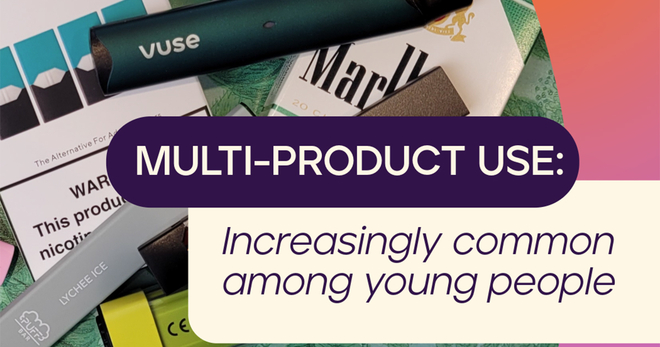Six highlights from the Tobacco Control special issue on flavors
With flavors that can seem like they belong in a candy shop—including strawberry, cinnamon, vanilla, coconut, licorice and chocolate—some tobacco products may appear to be less harmful than others.
A new special issue of Tobacco Control takes on flavored tobacco with 13 studies spanning a spectrum of products. In the journal’s opening editorial, four researchers featured in the issue, including Dr. Andrea Villanti, director for Regulatory Science and Policy at the Schroeder Institute® for Tobacco Research and Policy Studies, wrote that the research could help inform tobacco regulations in the U.S. and around the world.
Flavored tobacco products are often perceived as less harmful than other products, facilitating tobacco use habits that can lead to a lifetime of addiction.
“Flavored tobacco products are widely considered to be ‘starter’ products for young users and may encourage experimentation or reduce ‘harshness’ associated with more established products,” wrote the researchers.
Although the U.S. Food and Drug Administration banned cigarettes with these and other characterizing flavors in 2009, there is a large marketplace for flavored tobacco products. That’s because the ban excludes menthol, a cooling mint-derived flavor that makes cigarettes easier to smoke and harder to quit, and does not cover other tobacco products, such as e-cigarettes, hookah, cigars and little cigars or cigarillos.
We’ve rounded up some insights from the issue about the impact of flavors in tobacco products. For more, read Tobacco Control’s special issue.
1. Children could have a sweet tooth for flavored tobacco products.
Researchers reviewed 474 studies to analyze how preferences differ between children and adults for flavors used in tobacco products. They found that children have “elevated sweet and salty preference relative to adults, with ‘sweet’ food odors highly preferred by children.”
2. Tobacco companies have long used flavored smokeless tobacco to appeal to young users.
A review of information about flavored smokeless tobacco in industry documents shows that companies have consistently linked flavors with “young and inexperienced users.” The documents, from the Truth Tobacco Documents Library, are dated from 1958 to 2011. The researchers found that smokeless tobacco products with “candy-like sweeter milder flavors”—such as mint and fruit—“could increase appeal to starters by evoking a perception of mildness, blinding the strong tobacco taste and unpleasant mouth feel.”
Using flavored brands or ‘candy dips’ was likened to sucking on a candy or a Lifesaver by experienced users; and was considered to be characteristic of beginners.
–Findings from a tobacco company focus group on smokeless tobacco
3. The youngest smokers are the most likely to use menthol cigarettes.
Data from 2004 to 2014 show that, while non-menthol cigarette use declined, the prevalence of menthol cigarette use increased among smokers. On top of that, youth smokers were the age group most likely to smoke menthols, and they smoked them at higher rates than non-menthols.
4. Young people are more likely to try flavored e-cigarettes and believe they are less harmful than tobacco-flavored e-cigarettes.
In a national survey of more than 1,000 13- to 17-year-olds, researchers asked about the appeal of certain e-cigarette flavors. The respondents said they were more likely to try an e-cigarette flavored with menthol, candy or fruit than a tobacco-flavored e-cigarette, and they believed products with those flavors—especially fruit—were less harmful than tobacco-flavored ones.
5. Adults also like flavors—a majority of adult users of e-cigarettes, hookah and smokeless tobacco prefer flavored varieties.
Researchers looked at the 14 percent of U.S. adults who used a tobacco product other than cigarettes from 2013 to 2014. They found that more than half of those who used e-cigarettes, hookah, and smokeless tobaccoused a flavored variety of the product in the past 30 days. That amounted to 51 percent of smokeless tobacco users, 68 percent of e-cigarette users and 82 percent of hookah users consuming flavored products. More than a third (36 percent) of cigar smokers used a flavored cigar in the past month.
In a separate study, adult research participants were more likely to report liking e-cigarettes with flavor characteristics of sweetness and coolness. Flavors eliciting bitterness and harshness, which researchers noted is most likely from nicotine, negatively impacted liking the e-cigarette, suggesting that “flavors play an important role in e-cigarette preference and most likely use.”
6. Flavored tobacco users are less likely to make a quit attempt than non-flavored tobacco users.
Past research shows that menthol cigarette smokers have lower quit rates than non-menthol cigarette smokers. New research reveals a similar issue for users of flavored tobacco products. Users of flavored non-cigarette tobacco products were less likely to report that they had tried to quit in the past year than those using non-flavored products.
More in emerging tobacco products
Want support quitting? Join EX Program
By clicking JOIN, you agree to the Terms, Text Message Terms and Privacy Policy.
Msg&Data rates may apply; msgs are automated.


